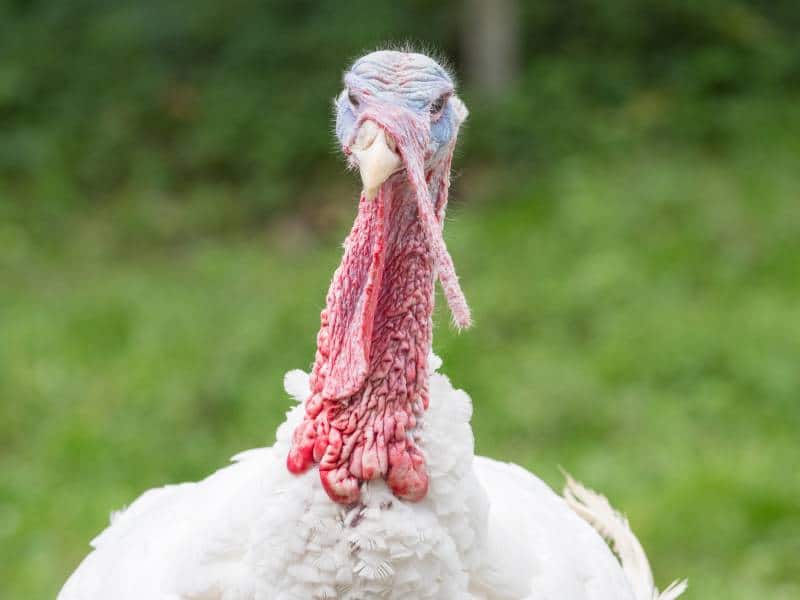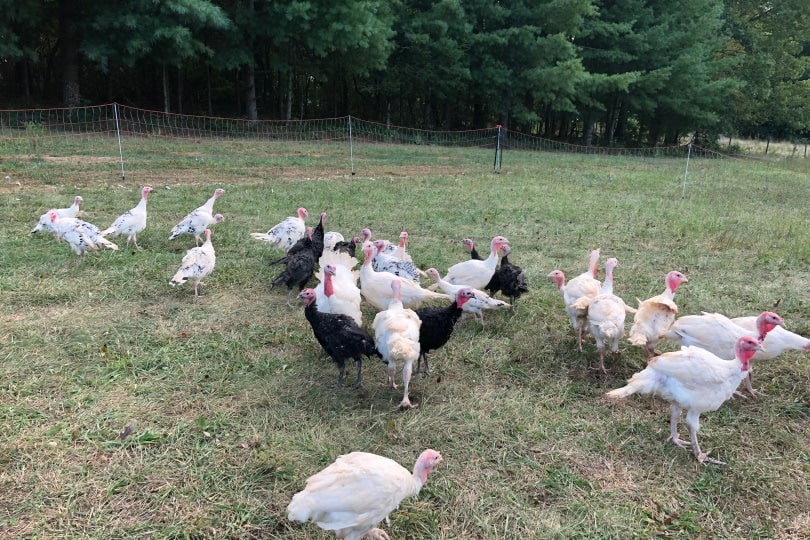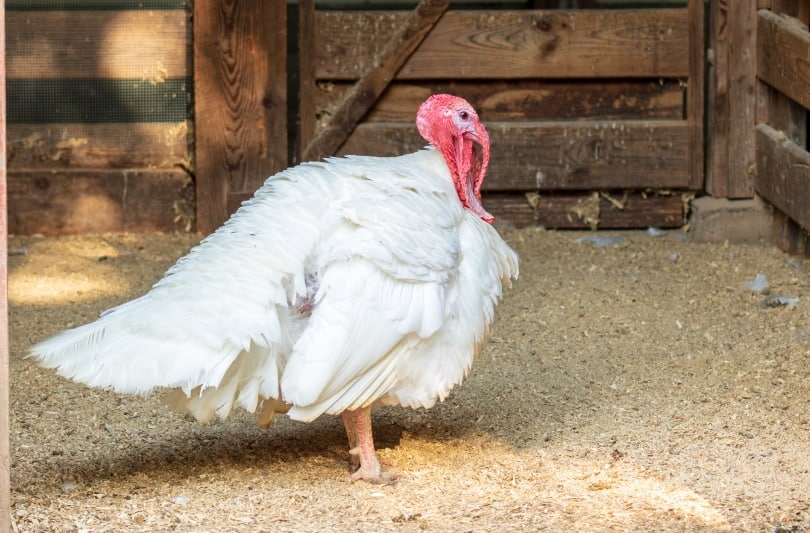If you’ve purchased a turkey from the grocery store in the last 60 years, there’s a 99% chance you bought a Broad Breasted White turkey. The massive, white-feathered bird is used more than any other breed; commercial chicken farms typically house around 10,000 birds to keep up with the American demand for turkey meat. The White turkey was not always the country’s top bird, but it was created to meet the rising demand for low-cost turkey with more breast meat than other birds. Although poultry farmers consider it a success story, the White turkey is vulnerable to several medical conditions and rarely lives past five years.

Quick Facts about Broad Breasted White Turkey
| Breed Name: | Broad Breasted White Turkey |
| Place of Origin: | United States |
| Uses: | Meat |
| Tom (Male) Size: | 30-40+ pounds |
| Hen (Female) Size: | 14-20 pounds |
| Color: | White |
| Lifespan: | 2-5 years |
| Climate Tolerance: | Hot and cold climates |
| Care Level: | Minimal |
| Production: | More breast meat than other breeds |
| Egg-laying: | Hens produce a limited amount |
Broad Breasted White Turkey Origins
During the Great Depression of the 1930s, Americans preferred smaller turkeys with more breast meat that fit into an icebox. The Beltsville Agricultural Research Center responded in 1934 by creating the Beltsville White turkey, and it dominated the market until the creation of the Broad Breasted White turkey in the early 1960s. It was produced by crossbreeding a Broad Breasted Bronze Turkey with a White Holland. The Broad Breasted White was another response to changing consumer demand. Instead of a smaller bird, Americans wanted a large turkey with even more breast meat.

Broad Breasted White Turkey Characteristics
Unlike the previous bird that dominated the market, the Broad Breasted White turkey is an enormous bird with shorter breast bones that support more meat than any other breed. One reason turkey farmers prefer the White breed is its rapid development. Hens can enter the slaughterhouse when they’re only 14 weeks old, and toms can be butchered when they’re 18 weeks old. Although hens produce high-quality eggs, they’re usually not for sale to the public. The eggs have a high rate of hatching, and few can be sold as infertile eggs.
The Broad Breasted White turkey transformed the turkey industry with its high yields of meat, but unfortunately, the increased production characteristics came at the expense of the bird’s health. Genetic diversity is lacking in White turkeys, and most adult birds that are spared from the slaughterhouse do not live comfortable lives before dying. They’re prone to joint problems, cardiac issues, skeletal weakness, and a limited immune response to pathogens. Commercial turkeys are pumped full of antibiotics to prevent illnesses, but most breeders and animal groups believe the issues cannot be solved with medications or traditional breeding techniques.
Unlike wild turkeys that get to roam and forage freely, commercial white chickens are crammed in tiny spaces and forced to eat high-fat turkey feed to ensure they reach the market standard for weight. The turkey’s breasts are so large that the birds are unable to reproduce naturally. All White turkeys are artificially inseminated. The Humane Society and PETA have repeatedly warned consumers about the inhumane conditions on industrial turkey farms.
Broad Breasted White Turkey Uses
The United States slaughters over 250 million White turkeys every year for meat. Less than 5 months after birth, the turkeys are loaded haphazardly in large trailers and taken to the slaughterhouse. Conditions on the truck are even worse than on the farm. Large operations can load up to 1,500 turkeys per hour into the truck, and many birds break their wings or suffer from internal hemorrhaging in the loading process. The turkeys are not given food or water during the trip, and some are not stunned before they’re butchered. Efficiency is more vital to turkey producers than humane treatment, and although the United States and much of the world love turkey meat, it comes at a high cost.
Broad Breasted White Turkey Appearance & Varieties
Broad breasted white turkeys have white feathers, red carnucling, a black beard, and pink feet. The bird’s large breasts weigh the bird down, and the full-grown turkeys seem off balance when they waddle around. One of its relatives, the Broad Breasted Bronze turkey, was a popular commercial bird until it was replaced by the Beltsville White. Consumers in the early 20th century were bothered by the color of the Bronze turkey’s meat. The bird’s dark plumage affected the color of the flesh, and breeders decided to create a white-feathered bird that would not change the meat’s pigment. The Broad Breasted White turkey is favored because of its near-perfect carcass appearance. However, the genetic manipulation that created the White bird also made it more vulnerable to obesity. If the White turkeys in a commercial farm gain weight too fast, their keepers starve them for a few days to keep them within the required weight limit.

Population, Distribution & Habitat
Genetically, White turkeys are not healthy animals, but they’re considered hardy species less affected by climate conditions. Except for Antarctica, white turkeys live on every continent in the world. Their largest population is in the United States. The animals are raised in cramped conditions in large turkey farms, but small farmers often let them forage on free-range lands. Unlike chickens, turkeys have few predators and require less supervision to keep them safe. When farmers supply a spacious coop for the turkeys and feed them a healthy diet, they can live up to 5 years.

Are Broad Breasted White Turkeys Good for Small-Scale Farming?
Homesteads and small farms keep Broad Breasted White turkeys, but heritage turkeys are more reliable for small-scale farming. White turkeys were designed to produce the largest amount of meat, but they’re more vulnerable to diseases and other medical conditions than heritage birds. Also, heritage species are preferred by chefs for their enhanced flavor and lean meat. Some examples of heritage birds include Standard Bronze, Royal Palm, Bourbon Red, Narragansett, Auburn, and Black. If you decide to raise Broad Breasted White turkeys rather than heritage types, you’re unlikely to have problems with aggression. White turkeys are docile creatures that appreciate humans who treat them humanely.
Featured Image Credit: Jennifer Yakey-Ault, Shutterstock
